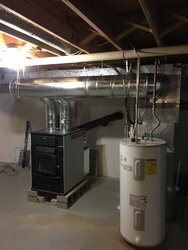Another tip for anybody just starting out with this whole wood heat thing, load according to the weather forecast. I have 5 basic strategies, starting with warmer weather and working down to "Polar Vortex"
1. Load light every 12 hours. On a light load I load the wood in an X shape (corner to corner) alternating the direction of each layer so you end up with about half the wood, but it is still "to the top" It burn hot this way, just not for as long.
2. Load full every 12 hours. A full load is basically 2 side by side rows even to the top of the loading door.
3. Load light very 8 hrs.
4. Load full every 8 hrs.
5. And last but not least, for those really cold nights, fill 'er up, as much as you can get in without damaging the baffle/tubes!
And this list doesn't even account for all the different types of wood that can be used, as far as softwood/hardwood.
Doing this wood heat thing well is a real skill! Well, except for those Kuuma cheaters!



 , and I haven't done anything like leaving the door cracked open. It just won't get hotter. but goes into secondary and holds it and cycles nicely with these settings. I am getting 6-10 hours of burn time and great heat output. I say 6 because yesterday was our first below 20 degrees with 15-20mph winds.. the BD was working but the furnace was flying through the wood compared to a non windy day. But the house stayed above 70. I have a magnetic temp gauge on the furnace just to the lower left of the heat exchanger door. After the timer shuts off it will be around 375-550 just depending.... and the the damper will cycle and maintain that as long as there is fuel... I am not having coal build up and am getting great burn times IMHO. Good luck and have fun playing with your settings.... I am sure when I change to different wood I may have to adjust my settings! I have also opened the heat exchanger after a month of burning and I only had a light build of very flaky easily removed black ash.... honetly ran my shop vac down it and it sucked it right up.... the lowe flue temps kinda made me wonder if I would have build up.. but so far so good...
, and I haven't done anything like leaving the door cracked open. It just won't get hotter. but goes into secondary and holds it and cycles nicely with these settings. I am getting 6-10 hours of burn time and great heat output. I say 6 because yesterday was our first below 20 degrees with 15-20mph winds.. the BD was working but the furnace was flying through the wood compared to a non windy day. But the house stayed above 70. I have a magnetic temp gauge on the furnace just to the lower left of the heat exchanger door. After the timer shuts off it will be around 375-550 just depending.... and the the damper will cycle and maintain that as long as there is fuel... I am not having coal build up and am getting great burn times IMHO. Good luck and have fun playing with your settings.... I am sure when I change to different wood I may have to adjust my settings! I have also opened the heat exchanger after a month of burning and I only had a light build of very flaky easily removed black ash.... honetly ran my shop vac down it and it sucked it right up.... the lowe flue temps kinda made me wonder if I would have build up.. but so far so good...
